Search the Special Collections and Archives Portal
Search Results
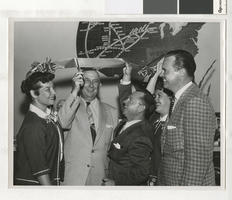
Photograph of Western Airlines office opening, Las Vegas (Nev.), June 1955
Date
1955-06
Archival Collection
Description
The opening of the Western Airlines office in the Riviera Hotel. Standing from left to right are: Doris Parlaman, Mayor C.D. Baker, Mickey Rooney, Shirley Fox, and Arthur F. Kelley (VP, Sales, Western Airlines). They are cutting the ribbon at the opening ceremony. Site Name: Riviera Hotel and Casino (Las Vegas, Nev.) Street Address: 2901 South Las Vegas Boulevard
Image

Photograph of a horse drawn stagecoach, Tonopah (Nev.), circa 1905
Date
1904 to 1906
Archival Collection
Description
Horse drawn stage leaving Tonopah for Manhattan, circa 1905. There was an inscription on the image. "The coaches were the primary mode of passenger transportation between central Nevada's early mining camps. They were eventually replaced by railroads which built into Rhyolite, Goldfield, Tonopah, and Blair, but served the area's smaller satellite camps until the mid-1910's when the automobile took their place. The photo was reproduced from an original 1905 colored postcard."
Image
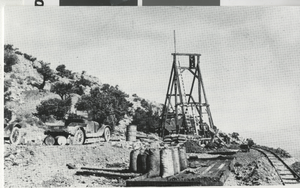
Postcard of the Harmill silver-lead mine, Montezuma (Nev.), 1929
Date
1929
Archival Collection
Description
The Harmill was being operated by Gerald B. Hartley, Sr. and was worked through the 1930s. (Gerald B. Hartley, Jr. Collection) There was an inscription on the image. "The Montezuma district was laid out after the discovery of ore in the area on May 24, 1867 by Thomas Nagle, Mat Plunkett, and a Mr. Carlyle. The district was active through the 1880s after which mining came to a standstill. Montezuma experienced a revival in the early 1900s on the heels of the Goldfield boom. Mining continued through the 1930s from operations such as the Harmill. Ore was chiefly silver accompanied by lead with some gold. Recorded production from the district was over $500,000."
Image
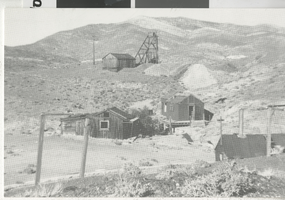
Postcard of Klondyke (Nev.), 1963
Date
1963
Archival Collection
Description
Located 10 miles southeast of Tonopah, the camp was settled in the late 1890s when silver and gold was discovered in the area. In May, 1900, when Jim Butler picked up his first samples at the site that would become Tonopah, he was en route to Klondyke. He offered the local assayer, Frank Higgs, an interest in the find for an assay, but Higgs declared the samples worthless and threw them out. Fortunately, Butler retrieved more samples on this return trip to Belmont. The building on the right with the large smoke-stack was the assay office. None of the structures remain today.
Image

Postcard of Candelaria (Nev.), ca 1887
Date
1887
Archival Collection
Description
Candelaria was born as a result of silver mining in the area. Silver was discovered nearby in 1863 and large scale mining began in 1873. The town-site was laid out in 1876 and soon supported saloons, stores, a newspaper, schools, and a railroad, the Carson and Colorado, which reached town in 1882. Peak population was over 1,500, recorded in 1883. The mines most prosperous years were during the 1880s, although mining continued through the 1950s with a total production of over $21,000,000. Candelaria was virtually deserted by 1940 and had become a ghost town by 1950. Large scale open pit mining began in 1977 and continued through 1996.
Image
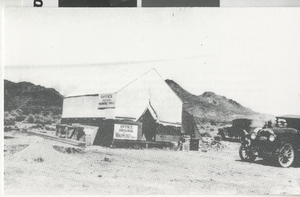
Postcard of Wahmonie (Nev.), 1928
Date
1928
Archival Collection
Description
The original Wahmonie Townsite Company was doing a brisk business selling lots in the new camp. Wahmonie came on the scene following the discovery of rich gold-silver ore near the site January 31, 1928. Within a month the population reached 200. A post office opened in April serving over 800 people and by mid-summer, the town reached its peak of over 1,000 residents. George Wingfield of Goldfield fame purchased the most promising properties and began immediate development. Unfortunately, the ore did not continue with depth and Wahmonie was abandoned within a year. Wahmonie was located 35 miles southeast of Beatty and the site lies within the Las Vegas Bombing and Gunnery range.
Image
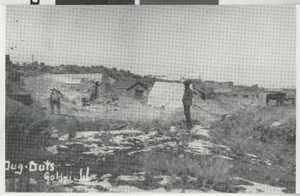
Postcard of dugout houses in Goldfield (Nev.), 1904
Date
1904
Archival Collection
Description
In most central Nevada mining camps, building materials were scarce during early development. Empty bottles, cans and stones were used to fabricate dwellings. In Goldfield, dugout homes were built into the walls of the two largest washes that crossed the townsite. The dugouts were cool in the summer and warm in the winter. The major disadvantage was size. Most were limited to one room. As building materials became available, conventional housing soon replaced the dugouts. The majority of Goldfield's dugouts were destroyed in the flood of 1923, although a few can still be found in the smaller washes on the west edge of town.
Image
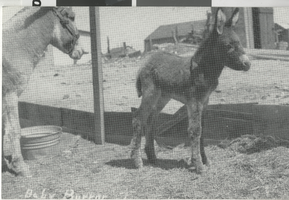
Postcard of a baby burro, Tonopah (Nev.), 1905
Date
1905
Archival Collection
Description
There was an inscription on the image. "The burro was the principal form of transportation used by prospectors in central Nevada at the turn of the century. The prospectors had a love-hate relationship with the animals, which were dependable and well adapted to the desert region, although they could be stubborn and cunning. As the automobile became the accepted mode of transportation, the burros were turned loose and roamed the streets and local trash dumps of the area's towns. They were one of the principal forms of entertainment for local children until they gradually disappeared from the metropolitan areas in the 1920s. The burros that roam Death Valley and the Marietta area of central Nevada today are descendants of those left behind by the prospectors."
Image
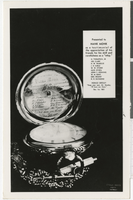
Postcard of a watch given to Hank Monk, circa 1863
Date
1862 to 1864
Archival Collection
Description
A commemorative postcard of a watch given to Hank Monk. The front of the postcard reads: "Presented to Hank Monk as a testimonial of the appreciation of his friends for his skill and carefulness as a "whip." N. Thompson, Jr., Joe Clark, H. W. Wakelee, J. O. Earle, W. W. Stowe, Alex O'Neil, John S. Henning, W. M. Kent, Geo. Hearst, H. H. Raymond. Horace Greeley "Keep your seat, Mr. Greeley; I'll have you there." Dec. 1st, 1863."
Image
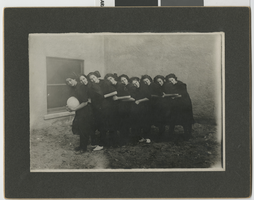
Photograph of the Clark County High School girls' basketball team, Las Vegas (Nev.), 1912
Date
1912
Archival Collection
Description
The Clark County High School girls' basketball team poses with a ball. Later the school was renamed Las Vegas High School. Louella Franses Wengert (Ham) is the first girl to the left holding the ball. Site Name: Las Vegas High School (Las Vegas, Nev.)
Image
Pagination
Refine my results
Content Type
Creator or Contributor
Subject
Archival Collection
Digital Project
Resource Type
Year
Material Type
Place
Language
Records Classification
